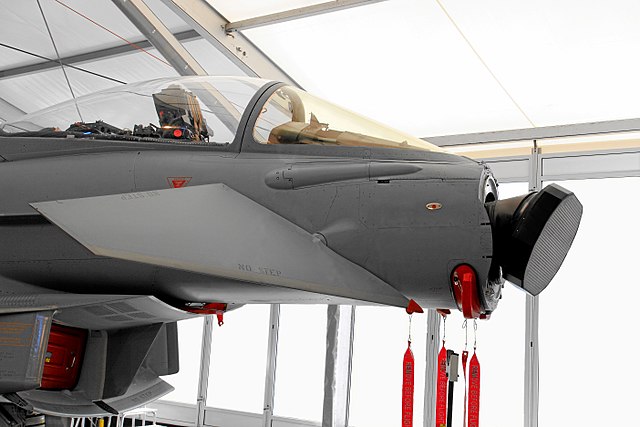Active electronically scanned array
An active electronically scanned array (AESA) is a type of phased array antenna, which is a computer-controlled antenna array in which the beam of radio waves can be electronically steered to point in different directions without moving the antenna. In the AESA, each antenna element is connected to a small solid-state transmit/receive module (TRM) under the control of a computer, which performs the functions of a transmitter and/or receiver for the antenna. This contrasts with a passive electronically scanned array (PESA), in which all the antenna elements are connected to a single transmitter and/or receiver through phase shifters under the control of the computer. AESA's main use is in radar, and these are known as active phased array radar (APAR).
The Eurofighter Typhoon combat aircraft with its nose fairing removed, revealing its Euroradar CAPTOR AESA radar antenna
ZMAR concept sketch, 1962
An aerial view of the three domes of the Multifunction Array Radar prototype, surrounded by a clutter fence, at White Sands Missile Range, N.M.
Sketch of the FLAT TWIN antiballistic missile radar
In antenna theory, a phased array usually means an electronically scanned array, a computer-controlled array of antennas which creates a beam of radio waves that can be electronically steered to point in different directions without moving the antennas.
The general theory of an electromagnetic phased array also finds applications in ultrasonic and medical imaging application and in optics optical phased array.
US PAVE PAWS active phased array ballistic missile detection radar in Alaska. Completed in 1979, it was one of the first active phased arrays.
Closeup of some of the 2677 crossed dipole antenna elements that make up the plane array. This antenna produced a narrow "pencil" beam only 2.2° wide.
Active Phased Array Radar mounted on top of Sachsen-class frigate F220 Hamburg's superstructure of the German Navy
AN/SPY-1A radar installation at National Severe Storms Laboratory, Norman, Oklahoma. The enclosing radome provides weather protection.








